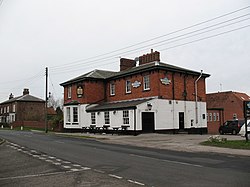Wheldrake
| Wheldrake | |
| Yorkshire East Riding | |
|---|---|
 The Wenlock Arms, Wheldrake | |
| Location | |
| Grid reference: | SE682449 |
| Location: | 53°53’46"N, 0°57’40"W |
| Data | |
| Population: | 2,107 (2011) |
| Post town: | York |
| Postcode: | YO19 |
| Dialling code: | 01904 |
| Local Government | |
| Council: | York |
| Parliamentary constituency: |
York Outer |
| Website: | Wheldrake Parish Council |
Wheldrake is a village in the East Riding of Yorkshire, standing seven miles south-east of York. The 2011 census recorded the parish with a population of 2,107.
The parish of Wheldrake was in the possession of Fountains Abbey in the Middle Ages. It became part of a landed estate until the mid 20th century. It has a significant conservation area and a nature reserve of international importance. This, named Wheldrake Ings, is a mile east of the village, and is where many wild flowers flourish and rare birds prosper.
Most of the employed people who live in the village commute to work. There is a primary school, a church, a shop with post office and a public house which serve 761 households. There is a small industrial estate near the western approach to the village.
The parish church is and St Helen's.
About the village
The Wheldrake Ings are part of the internationally significant nature reserve of the Lower Derwent Valley which is a site of special scientific interest and a Ramsar Convention site.[1]The Ings are areas of flood meadows along the river Derwent which flood seasonally and are rich in wildlife. They are mainly recognised for their significant collection of birds but they also support significant collections of mammals, plants and invertebrates.
Wheldrake Woods in the north of the parish was planted by the Forestry Commission and has mainly conifer trees.[2] The open cultivated agricultural land is not species-rich but the hedgerows, field margins and roadside verges support some small mammals and an increasing number of grasses and flowering plants.
History
On air photographs an extensive Iron Age or Roman field system is visible as crop marks. There are ditched enclosures, round houses, enclosures, a track way and possibly a square barrow. In 2002 a Roman farm was discovered at Wheldrake. Excavation of the site revealed structural remains, four Roman graves, animal bones, pottery and the remains of a main Roman road.[3]
The Domesday Book of 1086 records that before the Conquest the land was held locally by a man named Norman but the overlord of the area was Morcar, Earl of Northumbria. It was worth 20 shillings in tax and there was enough arable land for four ploughs to be used, but by 1086 it had been granted to William de Percy and was known as Coldrid.[4] The local lord was William Coleville. There was extensive woodland, twenty acrea of meadow, three fisheries, a water mill and the church.
Several gifts of land in Wheldrake were made to monasteries and by the end of the 15th century Fountains Abbey owned a large part of the land in the village.
When King Henry VIII dissolved the monasteries, the land in Wheldrake which had belonged to Fountains and other abbeys was confiscated and granted or sold to various private individuals.
The manorial lands were inclosed from 1773. In 1778–9, the body of the village church was demolished and rebuilt in the Georgian style, although the thirteenth-century stone tower was retained.[5]
Society and sport
- Wheldrake Singers, a local choral group
- Wheldrake Recreational Association, a venue for sports and social activities
Outside links
| ("Wikimedia Commons" has material about Wheldrake) |
References
- ↑ [ https://rsis.ramsar.org/ris/301 Lower Derwent Valley]: Ramsar Convention
- ↑ "Wheldrake Wood". https://www.forestryengland.uk/wheldrake-wood.
- ↑ "York & North Yorkshire News". http://www.bbc.co.uk/northyorkshire/news/2002/07/10/roman.shtml.
- ↑ "Domesday Book". The National Archives. https://www.nationalarchives.gov.uk/domesday/.
- ↑ Nikolaus Pevsner: The Buildings of England: Yorkshire: York & East Riding, 1972; 1995 Penguin Books ISBN 978-0-300-09593-7

